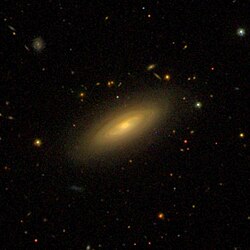| NGC 550 | |
|---|---|
 SDSS image of NGC 550 | |
| Observation data (J2000 epoch) | |
| Constellation | Cetus |
| Right ascension | 01h 26m 42.560s [1] |
| Declination | +02° 01′ 20.52″ [1] |
| Redshift | 0.019560 [2] |
| Heliocentric radial velocity | 5807 km/s [2] |
| Distance | 303.7 Mly (93.10 Mpc) [3] |
| Apparent magnitude (B) | 15.0 [2] |
| Characteristics | |
| Type | SB(s)a? [3] |
| Other designations | |
| UGC 1021, MCG +00-04-146, PGC 5374 [2] | |
NGC 550 is a spiral galaxy in the constellation Cetus. It is estimated to be about 300 million light-years from the Milky Way [3] and has a diameter of approximately 110,000 light years. The German-British astronomer William Herschel discovered it on 8 October 1785. [4] [5] [6]
Contents
One supernova has been observed in NGC 550: SN 1961Q (type unknown, mag. 17.2) was discovered by Milton Humason on 30 November 1961. [7] [8]